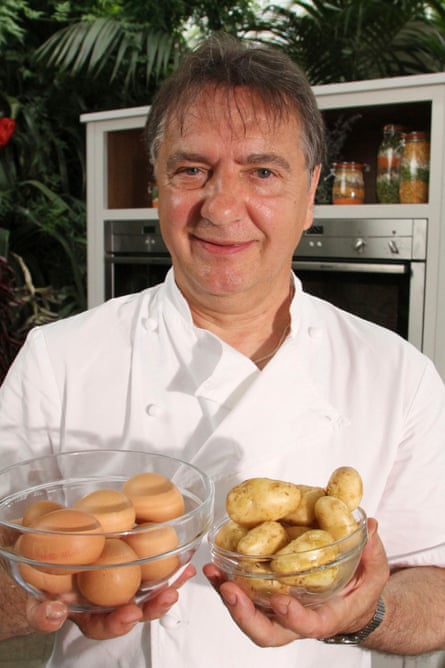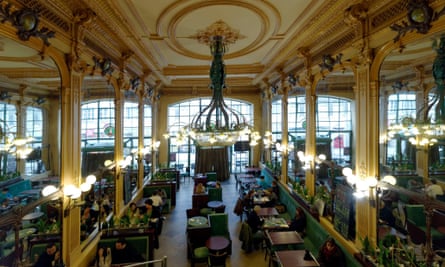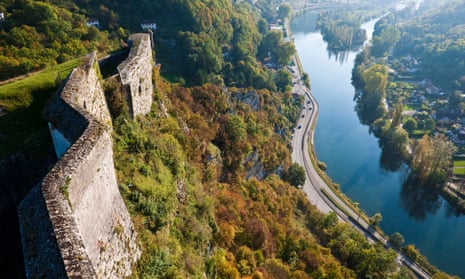I fell in love with food in Besançon. I was about 19 and having failed miserably at being a draughtsman, I was looking for my destiny. I saw this restaurant called Le Palais de la Bière on a wonderful summer night. The maître d’hôtel was carving meat and flambéing pancakes and there were lovers holding hands. It was so beautiful. Oh my God! I said I wanted to become the chef there. It didn’t happen straight away though – I became the cleaner first.
When I was 14, I saved all the money I made from selling the frogs, wild asparagus and mushrooms I collected so I could eat at Le Poker d’As restaurant – my first great food experience in Besançon. I felt rich. It’s a very old restaurant and they cooked things very differently from my maman. I ordered veal kidneys, which were so different to the earthy food I had experienced at home. So many different layers of flavours and textures. I had a half a bottle of the expensive Hermitage red wine and I was a bit sozzled and had spent all my money but I was very happy.

The Citadel is as beautiful as the pyramids. It’s a Unesco world heritage site and it’s extraordinary. It’s humbling to see the work of the great master Sébastien Le Prestre de Vauban, who was an architect and a soldier at the time of Louis XIV and created these defences that encircle the city. There are also Roman ruins – Julius Caesar had a good fight with the Gauls here.
Besançon’s streets are wide and open and there are bistros everywhere. They have spent millions of pounds on a new tramway, so you can park your car outside the centre and walk around. It’s beautiful, with lots of old buildings made from the pale blue stone of the Franche-Comté region.
My father designed a lovely map for me to hunt mushrooms when I was young and I used to go into the forest looking for morels. They grow under moss, so you have to hunt them by smell. They are conical with beautiful honeycombs and a distinct flavour. You must try croûte aux morilles, a classic Franche-Comté mushroom dish.
There are a lot of museums in Besançon, for a small city – it is very cultural and people are turned on to the arts there. There is the Musée de la Résistance et de la Déportation, which is about the local resistance during the second world war. My father helped to keep German prisoners there. To see the museum is extraordinary for me. There’s also the Musée des Beaux-Arts, which locals call the “little Louvre”.
The whole landscape defines its gastronomy. We have the Montbéliarde cows, which eat wild herbs and flowers, making some of the richest milk and Comté cheese, the king of the many marvellous Franche-Comté cheeses.
Go to Le Vin et l’Assiette, which dates back to the 15th century, to eat. Bernard Leroy, who is a friend of mine, owns this little restaurant. He has a big wine cellar, too. It’s just him, his chef and his wife. You will find that old French hospitality there.
I used to hang out often at Brasserie Du Commerce – a good place to go for a drink. It’s a beautiful 1870s building with an art deco front. The inside is ancient, beautiful and very grand.

There is lots to see and do outside of the city. The Royal Saltworks in nearby Arc-et-Senans is another Unesco world heritage site where you can see how salt was such a valuable commodity during the rein of Louis XV. In the nearby town of Arbois you can see Louis Pasteur’s house.
Besançon’s nickname is the Green City. We have the rugged Jura mountains to the south east and the vineyards to the south. It’s a very strong wine region with the Savagnin and Poulsard wines well worth a try.
Besançon has a lot of hotels, all quite affordable. I like Hôtel Le Sauvage on the way to the Citadel, about five minutes away from La Porte Noire. It’s a former monastery, and very cosy. I’d also recommend Hôtel De Paris and Hôtel Vauban.

Comments (…)
Sign in or create your Guardian account to join the discussion